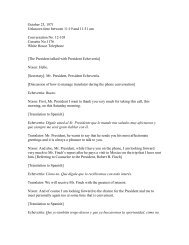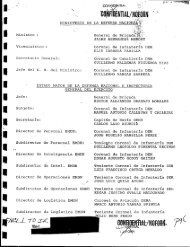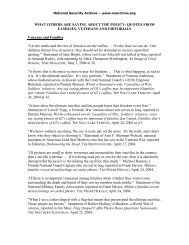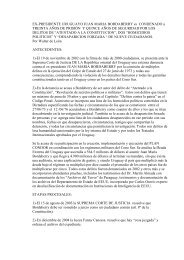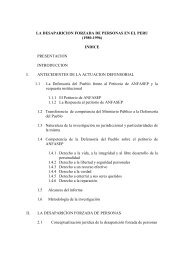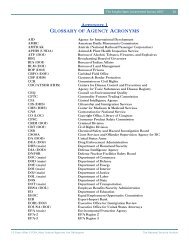TERRORISM 98 - FBI
TERRORISM 98 - FBI
TERRORISM 98 - FBI
You also want an ePaper? Increase the reach of your titles
YUMPU automatically turns print PDFs into web optimized ePapers that Google loves.
iological agents accounted for more than half of the<br />
WMD cases in 19<strong>98</strong>. By mid-19<strong>98</strong>, anthrax--also<br />
known as Bacillus Anthracis--had emerged as the<br />
agent of choice in WMD hoaxes.<br />
Anthrax spores are found naturally in diseased<br />
sheep and cattle and can also exist in other<br />
organic materials, including soil. This bacterial<br />
pathogen may be grown and exploited for illicit purposes.<br />
Anthrax spores can be spread in weaponized<br />
form in tiny, odorless clouds of gas that can be ingested<br />
through the nose and into the respiratory system.<br />
The spores are harmful only if inhaled, ingested, or<br />
when introduced into an open wound or the eyes.<br />
Anthrax-related threats can have significant<br />
ramifications for targeted communities. As demonstrated<br />
by recent hoaxes, a fabricated WMD threat<br />
may be as effective as an actual attack in achieving<br />
the desired terrorist objectives of creating public fear,<br />
mass panic, and disruption:<br />
• In April 1997, a suspicious package was sent<br />
to the Washington,<br />
D.C., headquarters of<br />
B’nai B’rith--a Jewish<br />
social service organization.<br />
Investigators<br />
found a shattered petri<br />
dish inside labeled with<br />
a misspelled variation<br />
of the word “anthrax”<br />
and “yersina,” the bacterium<br />
that causes<br />
Bubonic plague.<br />
Although the substance<br />
contained in the petri<br />
dish was ultimately<br />
determined to be harmless, the emergency<br />
response resulted in crippling traffic problems in<br />
the Scotts Circle area of the nation's capital and<br />
necessitated that workers in the building be temporarily<br />
quarantined while the package was transported<br />
and analyzed.<br />
• In August 19<strong>98</strong>, a threat was received at the<br />
Finney State Office Building in Wichita, Kansas,<br />
resulting in the evacuation of a large number of<br />
government workers from the building. Because<br />
of concerns that some of the workers had come<br />
into contact with a biological substance, the <strong>FBI</strong>’s<br />
Hazardous Materials Response Unit (HMRU) was<br />
deployed to the scene. Analysis revealed no biological<br />
agent present at the scene or in the collected<br />
evidence. Although interagency coordination<br />
resulted in a well-executed response, the incident<br />
still gained extensive media coverage, due in<br />
large part to copies of the threat letter that were<br />
mailed to newspapers and radio stations. The<br />
publicity generated by this hoax is suspected to<br />
have contributed significantly to a rash of copycat<br />
threats received around the country in the months<br />
following the incident.<br />
• In late December 19<strong>98</strong>, nearly two dozen<br />
anthrax threats were reported in greater Los<br />
Angeles, California. The threats--transmitted by<br />
telephone or mail--were ultimately determined to<br />
be fabricated. As a result of these threats,<br />
however, a large number of people were temporarily<br />
quarantined at Los Angeles area social, educational,<br />
and business sites,<br />
including a nightclub, a<br />
department store, an office<br />
building, a courthouse, and a<br />
high school. Arrests have<br />
been made in two of these<br />
threat cases. Some of the perpetrators<br />
were found to be<br />
pranksters or those wishing to<br />
avoid legal responsibilities.<br />
Since the arrests, the rate of<br />
anthrax threats in the<br />
Los Angeles area has<br />
diminished dramatically.<br />
● ANTHRAX CELLS<br />
Close Calls<br />
Since the early 1990s, the <strong>FBI</strong> has investigated a<br />
number of domestic extremist groups and associated<br />
individuals, as well as lone, unaffiliated individuals<br />
interested in procuring, or ready to employ, chemical<br />
or biological agents against perceived enemies or<br />
innocent civilians.<br />
• In April 1991, Leroy Charles Wheeler,<br />
Douglas Allen Baker, Richard John Oelrich, and<br />
Dennis Brett Henderson--members of the<br />
Minnesota-based Patriots Council (a small<br />
<strong>TERRORISM</strong> IN THE UNITED STATES 19<strong>98</strong><br />
13




